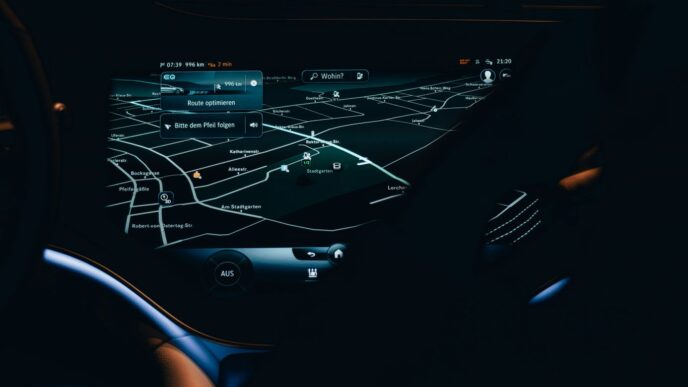Thinking about what’s next in tech? It feels like things are moving super fast, right? We’re talking about brand new invention ideas that could really change how we do things. From smarter AI to exploring space, 2026 is shaping up to be a big year for innovation. Let’s check out some of the coolest new invention ideas that are on the horizon.
Key Takeaways
- Agentic AI is moving beyond just helping us to actually doing tasks on its own, like running campaigns or managing logistics.
- Generative AI is getting smarter, combining different types of information like text, images, and code to be used in real business applications.
- Quantum computing is starting to offer real solutions for tough problems in medicine, finance, and climate science, even though it’s still early days.
- Space tech is opening up new business areas, from satellite services to manufacturing in orbit, making space more accessible for companies.
- Neural interfaces, or brain-computer interfaces, are developing ways for us to control devices with our thoughts, with big potential in healthcare and beyond.
1. Agentic AI And Autonomous Agents
Forget just having an AI assistant that answers your questions. By 2026, we’re talking about agentic AI, systems that can actually think, plan, and then do things on their own. Imagine an AI that doesn’t just suggest a marketing plan, but actually runs it, tests different versions overnight, picks the best one, and adjusts the budget based on how it’s doing – all before you even get to your desk. It’s a big shift from AI just helping us out to AI taking on entire jobs from start to finish.
The market for this kind of autonomous AI is expected to grow a lot, maybe reaching over 11 billion dollars by 2026. This isn’t just a small change; it’s reshaping how businesses work by mixing automation with the ability to figure things out and adapt.
What does this mean for companies? Well, they can make decisions much faster, cut down on mistakes people might make, and keep improving things all the time, way more than humans could manage alone. Think about a shipping company that can instantly change routes for hundreds of trucks when something unexpected happens, or a finance AI that tweaks investments on the fly to deal with market ups and downs.
Here’s a quick look at what some business leaders expect:
- ROI Expectations for Agentic AI Investments (2025 Survey of 100 CIOs):
- 62% expect over 100% return on investment.
- Average expected return: 171%.
This move towards AI that acts independently is creating new jobs too. People will be needed to design these agents, keep an eye on them, and make sure they’re working well and ethically. It’s about learning how to guide AI, make sure it’s used responsibly, and that its actions line up with what the business needs.
2. Generative AI 2.0

Generative AI is really starting to move beyond just playing around with text and images. By 2026, we’re going to see it become a standard part of how businesses operate, not just a cool experiment. Think of it as moving from a novelty to a workhorse. These systems are getting smarter, able to handle not just words and pictures, but also code and data all at once. They’re also getting better at finding information they need and following rules, which is a big deal for companies.
Companies are shifting from trying out AI on small projects to actually building it into their daily work. They’re feeding these AI models their own private data to make them more useful and putting them into secure systems that can be checked. This means AI can now do things like summarize long contracts, help write computer code, or look through medical records, all while keeping track of what it did and staying within company rules.
Here’s a look at how things are changing:
- From Experimentation to Integration: AI is moving from pilot programs to being a regular tool in the business.
- Multimodal Capabilities: AI can now understand and create content across text, images, code, and data.
- Domain-Specific Tuning: Models are being customized with specific company data for better performance.
- Built-in Governance: Features for retrieval, tool use, and compliance are becoming standard.
The focus is shifting from just using AI to actually seeing a return on investment. Businesses are realizing that AI can save time and money, and they’re looking for measurable results. This means things like making sure humans are still involved where needed, having ways to check the AI’s work, and making sure it’s fast enough to be useful. It’s all about making AI work for the business in a practical way.
3. Quantum Computing Applications
Okay, so quantum computing. It sounds super futuristic, right? But it’s actually starting to move out of the labs and into real-world stuff. Think about it: problems that would take our current computers ages to figure out, quantum computers could potentially solve in minutes or hours. We’re talking about things like discovering new medicines, creating advanced materials, or even figuring out super complex financial models. It’s a big deal because it means we can tackle challenges that were just too hard before.
Right now, a lot of the progress is happening with hybrid systems. These combine the power of quantum computers with regular, classical computers. It’s like getting the best of both worlds. They’re being used for things like:
- Drug Discovery: Simulating how molecules interact, which could speed up finding new treatments.
- Financial Modeling: Analyzing risks and optimizing investments in ways we couldn’t before.
- Materials Science: Designing new materials with specific properties, like stronger or lighter alloys.
The big promise here is that quantum computing could lead to breakthroughs that change entire industries. IBM, for example, is pushing hard to show what they call "quantum advantage" by 2026, which is a pretty significant goal. This isn’t just theoretical anymore; companies are actually running pilot projects. It’s still early days, and there’s a lot of work to do, but the potential is huge. We’re looking at a future where complex problems get solved much, much faster, opening up new avenues for innovation across the board.
4. Space Tech Innovations

It feels like just yesterday we were looking up at the stars and wondering, but now, we’re actually building things out there. Space tech is really taking off, and not just for governments anymore. Private companies are jumping in, making everything from better ways to launch stuff into orbit to even thinking about mining asteroids. It’s pretty wild.
What’s making this possible? Well, rockets that can be used again and again are a big deal, and so are tiny satellites that don’t cost a fortune. This means smaller businesses can get involved, which is awesome. Plus, everyone wants to see what’s happening on Earth from space in real-time, or get internet everywhere, so there’s a huge demand for new ideas. The space technology market was already over $466 billion in 2024 and is expected to hit $769 billion by 2030.
Here are a few areas that are really heating up:
- Launch Services: Think of it as a taxi service for satellites. Companies are making it cheaper and more frequent to get payloads into orbit. We’re seeing new rockets designed for different needs, like the Pegasus XL, which has a specific launch window coming up in June 2026.
- Satellite Data: Satellites aren’t just for pretty pictures anymore. They’re collecting all sorts of data about our planet – weather, agriculture, urban development. Businesses are finding ways to use this information to make better decisions.
- In-Orbit Servicing and Manufacturing: Instead of just launching things and hoping they work, we’re starting to fix and even build things while they’re already in space. This could change how we maintain satellites and build larger structures.
- Space-Based Energy: This is a bit more out there, but some are looking at collecting solar power in space and beaming it down to Earth. It’s a long-term goal, but the potential is massive.
Getting into this field isn’t cheap, and it takes time to get things approved and tested. You’re probably not going to see any money in the first year. But the possibilities are pretty mind-blowing.
5. Neural Interfaces
Okay, so imagine this: what if your thoughts could directly control things? That’s basically what neural interfaces, or brain-computer interfaces (BCIs), are all about. It sounds like something out of a sci-fi movie, right? But it’s actually becoming a real thing, and fast.
These systems are getting pretty good at translating brain signals into commands for computers, prosthetics, or other machines. Think about it – controlling a wheelchair with just your mind, or typing an email without touching a keyboard. It’s a huge deal for people who have lost mobility or the ability to speak.
Here’s a quick look at what’s happening:
- Restoring Independence: For individuals with conditions like paralysis or ALS, BCIs offer a way to regain control over their environment and communicate more easily.
- New Ways to Interact: Beyond medical uses, we’re seeing BCIs pop up in gaming and training simulations, letting you interact with digital worlds in a totally new, hands-free way.
- Future Possibilities: The market for this tech is growing, and by 2026, we’ll likely see even more practical applications emerge, moving beyond just the lab.
The big leap forward is in how well we can now process and understand those complex brain signals, often with the help of AI. It’s still early days, and there are challenges, especially with making these interfaces safe and reliable for everyday use. But the potential to change lives and how we interact with technology is massive. It’s a field where biology meets computing in some pretty amazing ways.
What’s Next for Innovation?
So, there you have it. We’ve looked at some pretty wild ideas, from AI that can actually think for itself to tech that reaches for the stars. It’s a lot to take in, I know. But the main takeaway is that things are moving fast. The tech world isn’t slowing down, and by 2026, we’re going to see some serious changes. Whether you’re an inventor, an entrepreneur, or just someone curious about the future, these trends show there are tons of opportunities out there. It’s exciting to think about what’s coming next and how these new inventions will change our everyday lives. Keep an eye on these areas – you never know what might spark your next big idea.
Frequently Asked Questions
What exactly are ‘agentic AI’ and ‘autonomous agents’?
Think of agentic AI as super-smart computer programs that can figure things out, make plans, and then actually do tasks all by themselves. Instead of just helping you write an email, an autonomous agent could plan a whole marketing campaign, run tests on it, and start the best one, all without you telling it every single step.
How is ‘Generative AI 2.0’ different from the AI we see now?
Generative AI 2.0 is like the next level up. Right now, AI can create text or pictures. But the new version will be able to mix different kinds of information – like words, images, and computer code – all at once. It will also be smarter, able to find information and use tools on its own, making it more useful for businesses.
What are some real-world uses for quantum computing?
Quantum computing is a powerful new type of computer. It could help us discover new medicines much faster, create better plans for managing money, and even predict climate changes more accurately. It’s still new, but it has the potential to solve really tough problems.
What kind of new ideas are coming from space technology?
Space tech is booming! Companies are thinking about new ways to use satellites for information, launching things into space more easily, and even building things in space. Some are even looking at mining asteroids or getting energy from space. Cheaper rockets and smaller satellites are making it easier for more companies to join in.
What are neural interfaces, and how might they be used?
Neural interfaces, also called brain-computer interfaces, are like a direct link between your brain and a computer or machine. They can translate your thoughts into actions, letting you control devices with your mind. This could help people with disabilities move artificial limbs, communicate, or even improve how we play games and work.
Are these new technologies expensive to develop?
The cost to start a business with these new technologies can vary a lot. Some, like certain AI tools, might have lower starting costs. However, things like quantum computing or advanced space technology often require a lot of money to get going. It really depends on the specific idea and how complex it is.














